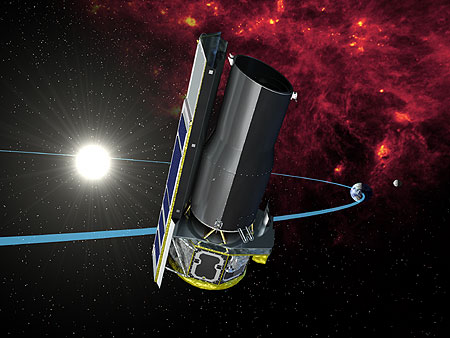Note4Students
From UPSC perspective, the following things are important :
Prelims level: Spitzer Telescope
Mains level: Significant feats of the mission

NASA’s Spitzer Mission, which studied the universe in infrared light for more than 16 years, will come to an end since it is low on fuel and has been drifting away from Earth for a few years now.
Spitzer Space Telescope
- The Spitzer Space Telescope is a space-borne observatory, one of the elements of NASA’s Great Observatories that include the Hubble Space Telescope and the Chandra X-Ray.
- Using different infrared wavelengths, Spitzer was able to see and reveal features of the universe including objects that were too cold to emit visible light.
- Apart from enabling researchers to see distant cold objects, Spitzer could also see through large amounts of gas using infrared wavelengths to find objects that may otherwise have been invisible to human beings.
- These included exoplanets, brown dwarfs and cold matter found in the space between stars.
- Spitzer was originally built to last for a minimum of 2.5 years, but it lasted in the “cold” phase for over 5.5 years. On May 15, 2009 the coolant was finally depleted and the “warm mission” began.
Major discoveries
- Spitzer also studied some of the most distant galaxies ever detected.
- The light from these galaxies reached us after traveling for billions of years, enabling scientists “to see those objects as they were long, long ago”.
- Hubble and Spitzer in 2016 identified and studied the most distant galaxy ever observed.
- Using these two telescopes, scientists were able to see a bright infant galaxy as it was over 13.4 billion years ago, roughly 400 million years after the Big Bang, when the universe was less than 5% of its current age.
- It assisted in the discovery of planets beyond our solar system, including the detection of seven Earth-size exo-planets orbiting the star TRAPPIST-1.
- Three of its seven planets were located in the “habitable zone,” where the temperature might be right for liquid water to exist on the planets’ surfaces.
Other landmarks
- Spitzer has logged over 106,000 hours of observation time.
- Thousands of scientists around the world have utilized Spitzer data in their studies, and Spitzer data is cited in more than 8,000 published papers.
- Spitzer’s primary mission ended up lasting 5.5 years, during which time the spacecraft operated in a “cold phase,” with a supply of liquid helium cooling three onboard instruments to just above absolute zero.
- The cooling system reduced excess heat from the instruments themselves that could contaminate their observations.
- This gave Spitzer very high sensitivity for “cold” objects.
- In July 2009, after Spitzer’s helium supply ran out, the spacecraft entered a so-called “warm phase.”
- Spitzer’s main instrument, called the Infrared Array Camera (IRAC), has four cameras, two of which continue to operate in the warm phase with the same sensitivity they maintained during the cold phase.
Get an IAS/IPS ranker as your 1: 1 personal mentor for UPSC 2024
